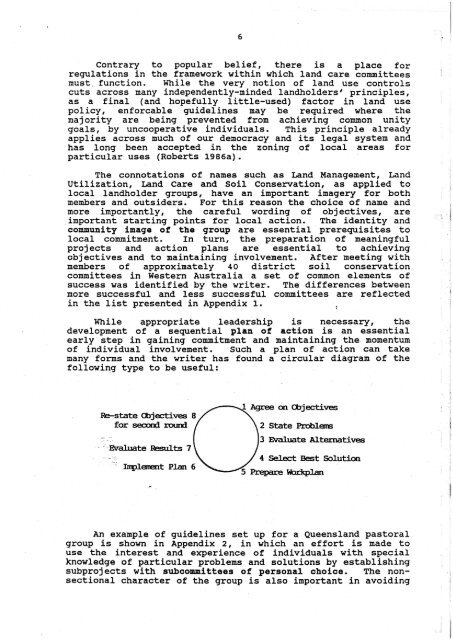soil-conservation-people-religion-and-land.pdf - South West NRM
soil-conservation-people-religion-and-land.pdf - South West NRM
soil-conservation-people-religion-and-land.pdf - South West NRM
Create successful ePaper yourself
Turn your PDF publications into a flip-book with our unique Google optimized e-Paper software.
Contrary to popular belief, there is a place for<br />
regulations in the framework within which l<strong>and</strong> care committees<br />
must. function. While the very notion of l<strong>and</strong> use controls<br />
cuts across many independently-minded l<strong>and</strong>holdersu principles,<br />
as a final (<strong>and</strong> hopefully little-used) factor in l<strong>and</strong> use<br />
policy, enforcable guidelines may be required where the<br />
majority are being prevented from achieving common unity<br />
goals, by uncooperative individuals. This principle already<br />
applies across much of our democracy <strong>and</strong> its legal system <strong>and</strong><br />
has long been accepted in the zoning of local areas for<br />
particular uses (Roberts 1986a).<br />
The connotations of names such as L<strong>and</strong> Management, L<strong>and</strong><br />
Utilization, L<strong>and</strong> Care <strong>and</strong> Soil Conservation, as applied to<br />
local l<strong>and</strong>holder groups, have an important imagery for both<br />
members <strong>and</strong> outsiders. For this reason the choice of name <strong>and</strong><br />
more importantly, the careful wording of objectives, are<br />
important starting points for local action. The identity <strong>and</strong><br />
community image of the group are essential prerequisites to<br />
local commitment. In turn, the preparation of meaningful<br />
projects <strong>and</strong> action plans are essential to achieving<br />
objectives <strong>and</strong> to maintaining involvement. After meeting with<br />
members of approximately 40 district <strong>soil</strong> <strong>conservation</strong><br />
committees in <strong>West</strong>ern Australia a set of common elements of<br />
success was identified by the writer. The differences between<br />
more successful <strong>and</strong> less successful committees are reflected<br />
in the list presented in Appendix 1.<br />
While appropriate leadership is necessary, the<br />
development of a sequential plan of action is an essential<br />
early step in gaining commitment <strong>and</strong> maintaining the momentum<br />
of individual involvement. Such a plan of action can take<br />
many forms <strong>and</strong> the writer has found a circular diagram of the<br />
following type to be useful:<br />
on Objectives<br />
stat<br />
far<br />
2 State Prdblem<br />
- . 3 Evaluate Alternatives<br />
- ' Evaluate Aesults 7<br />
- - 4 Select Best Solution<br />
- Irrplement Plan 6<br />
An example of guidelines set up for a Queensl<strong>and</strong> pastoral<br />
group is shown in Appendix 2, in which an effort is made to<br />
use the interest <strong>and</strong> experience of individuals with special<br />
knowledge of particular problems <strong>and</strong> solutions by establishing<br />
subprojects with subcommittees of personal choice. The nonsectional<br />
character of the group is also important in avoiding
















